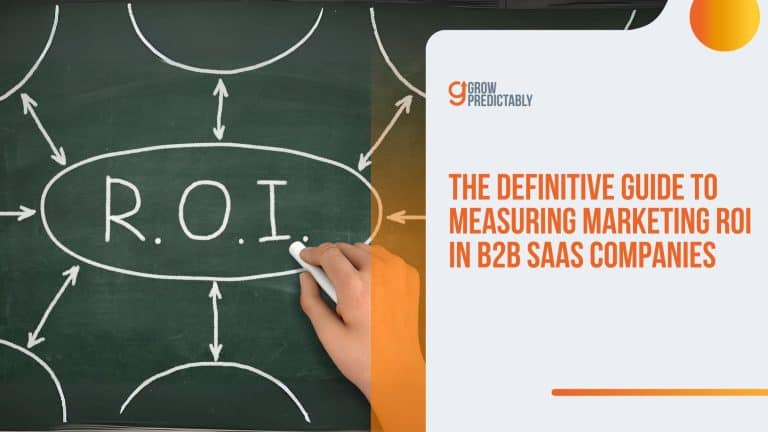Maximizing Growth: 13 Proven SaaS Marketing Strategy Essentials for 2025
This is for the SaaS companies who are having a tough time! Do you ever feel like your SaaS marketing is just shouting into the void?
You’re not alone.
Getting your SaaS solutions noticed and keeping customers hooked is tough.
But the thing is, a strategic marketing plan isn’t just a “nice-to-have” – it’s the difference between surviving and absolutely crushing it in this fast-paced industry.
Let’s be real, the SaaS market that SaaS companies are competing in is HUGE – billions of dollars huge – and it’s growing like crazy.
So, you need to play smart to make your mark!
Whether you’re a startup newbie or a seasoned SaaS marketing pro, a focused strategy is essential.
That means really understanding your customers, crafting SaaS marketing campaigns that connect with them, and showing them exactly what makes your SaaS so special in a sea of SaaS companies.
This guide is your roadmap. We’ll cover:
- Zeroing in on your perfect customer: Forget generic targeting – we’re going deep to find who really needs what you offer.
- Content marketing that converts: Move beyond “pretty” content and generate actual leads.
- Keeping customers coming back: Happy customers mean recurring revenue in the SaaS world!
Ready to get started? Let’s dive in!
- Crafting effective SaaS marketing strategies relies on setting clear goals, wise budgeting, comprehending the sales funnel, understanding the target audience, and creating buyer personas to tailor content that drives growth.
- SaaS content marketing, especially SEO-driven blogging, innovative social media strategies, and user-generated content, is critical in educating potential customers and boosting organic traffic for SaaS companies.
- Paid advertising, referral programs, and email marketing are pivotal in boosting SaaS visibility, nurturing leads, and converting SaaS customers into advocates. Tracking metrics like CAC, CLV, and MRR ensures the marketing efforts are result-oriented.
Understanding SaaS Marketing
Forget selling stuff you can stock on a shelf. A SaaS marketing plan is about selling software that lives in the cloud.
You’re basically selling a subscription service!
Think about old-school marketing – make a cool product, convince people to buy it, and repeat. SaaS marketing isn’t that simple.
Here’s why:
- No “try before you buy”: You can’t hand someone a free sample of your software. They need to trust it’ll do the job.
- It’s a marathon, not a sprint: Selling the software is just the start. You gotta keep customers happy month after month to make it work.
- Teach, don’t just sell: People might not ‘get’ your awesome software right away. You need to explain how it’ll make their lives better.
- Data is your best friend: Forget hunches – track how many people ditch your service and how much money you make each month…the numbers tell the real story.
So, how do you make this work? It’s all about having the right SaaS marketing strategies up your sleeve!
1. Crafting An Effective SaaS Marketing Plan
Let’s be real – the SaaS market is a total jungle out there.
You need something killer to make your product stand out. That’s where a smart SaaS marketing strategy comes in.
It’s your key to building a recognizable brand, the kind that sticks in people’s heads.
This isn’t just about getting new customers. It keeps the ones you have coming back for more.
I’ve learned this the hard way – you absolutely need a solid marketing plan if you want your SaaS to take off.
It’s not just about fancy tricks; it’s about actually connecting with people.
The key for me has been really digging into what keeps our potential customers up at night.
What are they worried about? What do they dream of achieving?
Once you get that, it completely changes how you talk about your product.
You go from just another vendor to a trusted partner.
Setting Clear Objectives
Think of your goals as your “mission control.”
Without them, your plan has no direction.
For example, maybe you wanna ramp up brand awareness with a killer social media campaign.
Here’s how to make your objectives laser-focused:
- Mix of short-term and long-term goals: Little wins keep you motivated!
- Break big goals into checkpoints: Helps measure progress.
- Know your market and what you can handle: Don’t overpromise.
- Deadlines and clear measurements for each goal: How else will you know if you’re crushing it?
- Be flexible: Things change; adjust your goals if needed.
Budgeting Wisely
Your budget is like the fuel for your SaaS marketing machine. Allocate it carefully to make sure you’re reaching your goals cost-effectively.
Here are some tips I’ve picked up:
- Align budget with your overall revenue: Makes sense, right?
- Ditch the discounts (at least early on): Focus on value first.
- Customer feedback is gold: What features do people REALLY want?
- Flexible payment plans: Let people choose what works for them.
- Transparent pricing: Nobody likes hidden fees.
- Sales team is your BFF: Their success helps you reinvest in SaaS marketing.
Tackling the Sales Funnel
Picture the sales funnel as your customer’s road trip.
You’re making sure it’s a smooth ride!
The Customer Value Journey (CVJ) is my go-to for understanding this trip.
The CVJ helps put things in order when SaaS marketing can feel chaotic.
It answers the big questions like…why do people buy, and how do you keep them coming back for more?
It’s all about getting in your customer’s headspace so you can attract, convert, keep them happy, and turn them into superfans who shout your praises from the rooftops.
CVJ stages broken down:
- Awareness: Get your name out there – ads, referrals, SEO, you name it.
- Engagement: Snag their attention with killer content marketing.
- Subscribe: Collect those precious emails!
- Convert: Get ’em to try a freebie or commit in some small way.
- Excite: Make them feel awesome about their choice.
- Ascend: Upsell more valuable services as they trust you.
- Advocate: Happy customers become your mini-salesforce.
- Promote: Encourage those advocates to refer your biz actively.
2. Identifying and Engaging Your Target Audience
Knowing your target audience is like having a super reliable compass.
It’s seriously that important for your SaaS marketing plan.
If you get this part right, all your SaaS marketing strategies will just click.
Building Customer Avatar Canvas
So, a Customer Avatar (or buyer persona) is basically like this super-detailed profile of your perfect customer.
Here’s the kind of stuff you want to nail down:
- Demographics: The basics – age, gender, where they live, what they do for a living, etc.
- Psychographics: This is where we dig into their head a bit – their values, lifestyle, what they like to do, even their personality type.
- Pain Points: What problems keep them up at night? What do you solve for them?
- Behavior Patterns: How do they shop, make decisions, all that good stuff.
- Goals and Aspirations: What are their big dreams, both personal and in their work life?
I know this might sound like a lot of work, but trust me, having this info makes everything easier when it comes to resonating with your target market.
You know exactly who you’re talking to, what they care about, and how to reach them so they’ll actually listen.
That means better results all around!
Mapping the Customer Journey
Think of mapping the customer journey, like following their footprints from the moment they first hear about you all the way to becoming a loyal customer (and hopefully a total fan!)
It’s about understanding what they need at each stage, making your job much easier.
By mapping this out, you determine the best ways to move people through the process.
Where do they get confused? What info do they need to make a decision?
This stuff is gold; it helps you ensure your SaaS marketing is always on point, which means more happy customers.
3. Developing a Unique Selling Proposition for Your SaaS Product
Your USP is your battle cry.
It’s what’ll make a potential customer stop scrolling and think, “Whoa, hold on. This is exactly what I’ve been looking for!”
The thing is, you need to address their actual struggles – the stuff that keeps them up at night.
Think about it this way: Have you ever tried to stand out from a huge crowd by whispering?
Doesn’t work, right? That’s what it’s like for SaaS companies trying to get heard without a killer USP.
The struggle is real!
You gotta speak directly to the most pressing issues of your existing customers, and make it feel like you get it.
We’ve all tried to be seen and heard in a world full of noise.
My experience has shown me: it’s not just about being different, it’s about showing how that difference makes their lives better.
Carve Out Your Space
The thing about SaaS?
Everyone’s always promising better this, faster that…
Your job is to make them scream “YES!” because you’re different.
So, start by figuring out what gives your existing customers a headache.
Map them out like a GPS route leading to the ultimate fix – which hey, is your product 😉
Remember, a strong USP isn’t just about uniqueness. It’s about solving their problems like no one else.
What’s that one thing your software does that kicks butt?
Maybe it’s transforming boring data into easy-to-use insights or making teams feel close even when they’re continents apart.
Nail Down Benefits Over Features
Look, we’re all proud of the features we’ve built.
But guess what actually gets customers to swipe that credit card?
Benefits!
Don’t be that boring sales rep rattling off a spec sheet.
Translate that tech lingo into how it helps your target market in their day-to-day.
How does your feature actually ease stress for someone in sales or help a marketing team get more done?
Show Them The Future
Make your audience imagine how awesome life will be with your product.
Ditch the vague ideas and give ’em specific success stories.
Highlight how other companies just like them are crushing it since they started using your software.
Demo Videos That Demonstrate Value
Nothing beats a good demo for showing value. It’s like letting them try it before they buy.
Bonus points if you can get a couple of customer testimonials.
Hearing another user raving about how you changed their workflow? That hits differently than anything you could ever write.
4. Content Marketing Mastery for SaaS Companies
Content marketing is how you get your awesome SaaS product in front of the right people.
It’s not just about listing features; it’s about showing folks how you can seriously improve their workflow or solve their pain points.
SEO-Driven Blogging
Picture your blog as the way to get noticed organically on search engines. You want to write the kind of stuff people are actually searching for and get Google excited enough to rank you higher. Here’s my checklist for making that happen:
- Optimize your titles and those little descriptions under the search links
- Come up with a solid SEO strategy that makes your brand the name in your niche
- Focus on writing content that people actually need and find useful
And don’t underestimate influencer marketing!
Team up with folks who have an audience that trusts them, and it can bring in a ton of leads and get more eyes on your SaaS.
Leveraging User-Generated Content
You know how when you love something, you want to shout it from the rooftops?
That’s user-generated content!
Your happy customers are your biggest cheerleaders.
Testimonials, case studies, reviews – anything they create showing how your SaaS rocks is basically marketing gold.
People trust people, so it can seriously boost conversions!
5. Innovative Social Media Strategies for SaaS
You know those stats everyone throws around about SaaS and social media?
The ones about better customer engagement and all that?
Well, turns out they’re true!
Building a strong social presence makes a HUGE difference.
It means 78% higher customer engagement and retention!
Honestly, some companies just don’t get it.
They talk at their audience, like a one-sided infomercial nobody wants to watch.
You gotta make it a conversation and actually interact with people!
Build a relationship, you know?
Choosing the Right Platforms
Picking your platforms wisely is key. You wouldn’t go fishing for tuna in a freshwater pond, right?
Same idea with social media.
Your audience dictates the best place to find them.
Here’s where most SaaS companies hang out:
- LinkedIn: The professional network, obviously
- Twitter: Concise updates, industry news
- Facebook: Broader reach, but depends on your audience
- YouTube: Great for demos, explainers
Campaigns That Resonate
Now, to make your campaigns actually work… here’s my take:
- Cut through the noise: What makes your message unique?
- Get personal: People connect with people, not just logos
- Build awareness slowly: Don’t oversell right away
- Niche groups: LinkedIn is perfect for this
- Actually engage! Respond to comments, questions, etc.
- Consistent voice: Don’t sound robotic or corporate all the time
- Show, don’t tell: What does your product DO that’s special?
6. Email Marketing: Nurturing Leads into Customers
Think of email marketing like your go-to tool for staying in touch with potential customers.
We’re not talking about spammy stuff, but building genuine relationships through your inbox.
Crafting Compelling Campaigns
When you’re writing an email campaign, imagine you want to get people excited – kind of like when you hear a super catchy song.
You want them to know your brand and ultimately, choose you.
How do you do that?
- Focus on the reader: What’s in it for them? Why should they care?
- Get more specific over time: Learn about your audience as they interact with you and tailor your emails to suit their needs.
- Keep it simple: No one wants complicated messages, so keep your emails focused.
- Make those calls-to-action count: What do you want people to do after reading your email? Make it super clear.
Personalization and Segmentation
So, those generic mass emails? People have gotten wise to those.
Studies show that personalized emails get way better results, and it makes sense – nobody likes being treated like just another number!
Here’s the trick to making it personal:
- Divide and conquer: Group your subscribers based on things they care about or how they found you.
- Get creative with content: Use their names, recommend stuff they’d like, stuff like that.
- Timing is everything: Automation is your friend here! Send emails based on where someone is in the buying process.
7. Paid Advertising: Boosting SaaS Visibility Quickly
Yeah, it can be a great way to get your SaaS product noticed fast.
Think of it like paying for a spotlight to shine on what you’re offering.
It covers stuff like Google Ads, those pay-per-click things, and ads on social media – all good tools for getting in front of more people and generating leads.
Look, I’m not gonna lie – paid advertising isn’t an instant fix.
It takes time, and there’s definitely a learning curve.
Don’t expect crazy results overnight. Think of it more like you’re carefully targeting where you plant the seeds for your SaaS company to grow.
If you’re ready to try it, my biggest piece of advice is to start small, experiment, and never forget who your ideal customer is.
You want EVERYTHING to be aimed at solving their problems.
Google Ads and PPC
This is all about those search results.
Get these right, and it’s like a strong wind pushing you to the top of the list where people will see you.
My tip: Be clear about your campaign goals, choose the right keywords, and target, target, target.
Social Media Advertising
Picture a crowded marketplace… social media is like that.
Ads let you wave a flag to catch the eye of potential customers.
This is where content shines – think blog posts, helpful guides, those kinds of things.
Pick the platform where your customers hang out, and you’re onto something!
8. Referral Programs: Turning Customers into Advocates
Have you thought about setting up a referral program? It’s a fantastic way to turn your happy customers into basically a mini sales force! You know how powerful it is when someone you know recommends a product or service? That’s the power of referrals.
Here’s how to get started:
- First things first: Make sure your customers LOVE your product. No referral program will succeed if your product isn’t great.
- Get creative with the rewards. What will really motivate your customers? Discounts, gift cards, free upgrades?
- Find a good referral management tool. This will make your life much easier and track results.
- Spell everything out. Make sure your referral program’s terms and conditions are crystal clear for everyone.
- Keep the process simple. You don’t want anyone getting confused about how to refer a friend. Make it super easy for them!
9. Measuring Success: Key Metrics for SaaS Marketers
You know, figuring out if your marketing stuff is working is like charting the waters – you want to make sure you’re on the right path to that treasure island of growth.
So here’s what we track to help us monitor SaaS churn more effectively:
- Customer Acquisition Cost (CAC): Consider this the gas money for your SaaS marketing machine. It’s all the bucks you spend to get a new customer. We keep a close eye on our CAC because, honestly, who wants to throw money out the window? Knowing this number lets us tweak campaigns to get the most bang for our buck.
- Customer Lifetime Value (CLV): These are your ride-or-die customers, the ones who bring in the real gold. CLV tells us how much revenue we can expect from a customer over time. Understanding this lets us figure out where investing more in keeping customers happy makes sense.
- Monthly Recurring Revenue (MRR): This is our heartbeat. MRR is the predictable, steady income that keeps the SaaS lights on. We watch it like a hawk to spot patterns and figure out what’s driving growth (or not).
Honestly, at our company, MRR is the ultimate truth-teller when it comes to marketing success.
It’s what cuts through the noise.
We analyze which marketing tactics are making our MRR tick upwards and which aren’t doing much. It’s less about what looks cool, and more about what straight-up gets results for our customers and for the business.
This way, we stay focused on what actually moves the needle and keeps our ship sailing smoothly.
10. Streamlining Customer Onboarding
Have you thought much about how we onboard new customers? It’s super important to get that process right.
You want to make it as easy and welcoming as possible.
After all, a good first experience is key to keeping people around.
Here’s what I’ve been thinking about when it comes to onboarding:
- Set some goals: What do you want new customers to achieve right away?
- Adoption programs: Can we make a few quick tutorials or something to get users hooked on our most important features?
- Stay organized: It helps to have a clear onboarding path – maybe even map it out!
- Data rocks: We can totally use analytics to help guide people through our product and show them what they’ll get out of it.
11. Retention Tactics: Keeping SaaS Customers Loyal
You know how much harder it is to get new customers than keep the ones we have?
That’s why we need a rock-solid plan to keep our SaaS subscribers coming back for more.
Here are a few things I’ve been thinking about:
- Get ahead of problems with top-notch support. Don’t wait for customers to complain, be proactive with help, troubleshooting, and even reach out to see how things are going.
- Actually listen to their feedback. Our customers tell us how to improve our product all the time, we need to use that info.
- Be upfront from the get-go. No one likes surprises. Tell new customers exactly what they can expect so there’s no misunderstanding later.
- Make those lightbulb moments happen! That feeling when a customer gets really excited about solving a problem with our product? Pure gold.
- Never stop proving how valuable we are. Remind them why they signed up, show off new features, and tailor offerings to their needs.
- Got a happy customer? Time for an upsell! They already trust us, so it’s a natural time to suggest upgrades or additional products.
- Little things matter. Regular tips, helpful hints, even a friendly check-in – these all remind customers we care about their success.
12. Building Trust Through Reviews & Testimonials
You know what they say, trust is everything in business.
And how do you build that trust?
Testimonials and reviews!
Working in B2B SaaS, I’ve learned trust is less about flashy stuff and more about showing up consistently for your clients.
Think of it like wanting a good handyman – you’re going to trust recommendations from others, right?
That’s how reviews and stuff work for us too.
Happy clients tell potential customers that we know what we’re doing and get their problems.
It shows we’re reliable.
Leveraging SaaS Review Sites for Credibility
Okay, so you launched your SaaS product.
Now what?
Get it on those review sites!
People are way more likely to trust something with social proof.
Potential customers check those sites before buying.
Having awesome reviews is a massive boost! It’s like adding a ton of credibility.
Capturing Valuable Feedback for Product Improvement
Let’s be real, we can’t read customers’ minds.
How else do we know what they really want?
Feedback is how!
Treat it seriously – it’ll tell you what’s working and what needs fixing.
Think of it like that honest friend who points out that your tag is sticking out. 😉
Use that stuff to make your product even better.
Incorporating Testimonials into Your Marketing Campaigns
Here’s the thing, good old-fashioned word-of-mouth still works wonders.
With SaaS, testimonials are about as close as we get. They show those awesome moments when your product shines.
Sprinkle them EVERYWHERE: emails, social media, anywhere your potential clients are looking.
Real experiences are what sells, not just sales pitches.
13. Scaling Up: Advanced SaaS Marketing Techniques
You know, scaling up always feels a bit like launching into the unknown, right?
But it’s where we need to be, and that means some more advanced marketing techniques.
Account-based marketing and marketing automation are the keys to making a bigger splash in the SaaS world.
Account-based Marketing (ABM)
Okay, think about ABM like this. Instead of casting this huge, wide net with our marketing, we’re laser-focusing on a select group of super important accounts. Like, the big potential clients. We figure out exactly what they need and tailor everything around that.
Here’s why ABM is awesome:
- Sales and Marketing BFFs: It gets both teams on the same exact page, working as one.
- Super Targeted: No more generic stuff – these campaigns hit the mark because we’ve done our homework.
- ROI Boost: We’re investing in the right places, so naturally, we see better returns.
- Client Love: This personalized approach makes clients feel special, which builds awesome long-term relationships.
Marketing Automation
This is where things get seriously efficient.
Think of it as having a robot handle all the repetitive marketing stuff – emails, social media, and all the follow-up.
This frees us up big time!
Why it matters:
- Time Savers: No more wasting time on the same old tasks. That time goes to actually being strategic!
- Personal Touch: We can still personalize messages to customers based on where they are in the process – that matters.
- Smart Leads: Marketing automation helps us see who’s really interested and ready to buy, making sales way easier.
- Data Power: All that tracking tells us what’s working and what’s not so we can keep getting better.
Summary
SaaS marketing changes fast. You absolutely need a solid plan to stay ahead of the game. Think of these 13 best SaaS marketing strategies as a guide on how SaaS companies skyrocket.
The biggest thing to remember? No one strategy is going to do it all. You need a good mix that’s custom-fit to your SaaS company and customers.
If you focus on really understanding your customers and giving them what they need, these strategies will help you rock the SaaS world. Ready to go?








